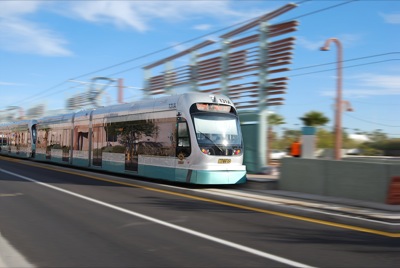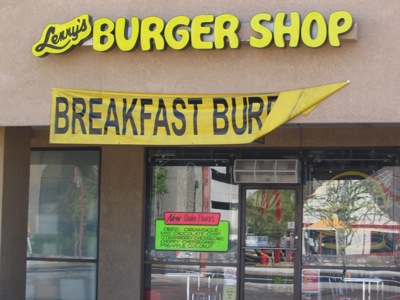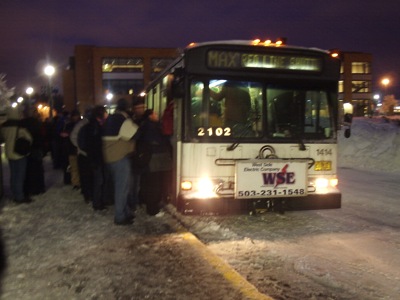Phoenix opened its $1.4 billion light-rail line for business on Saturday, December, 27. Thousands of people lined up to ride it during the first four days, when it was free.

Flickr photo by Phxwebguy.
Some riders were treated to a little extra excitement when light-rail trains were involved in several collisions with automobiles. The first accident took place on December 2, when Phoenix Metro was testing the system. The second collision happened on the day after it opened to the public. The car’s driver, apparently an illegal alien, fled the scene on foot.
But it was the third collision, less than a week later, that raised the most eyebrows. A pickup truck had stopped at a light-rail crossing for a train to go by. After the train passed, the crossing gates lifted, the light turned green, and the pickup tried to cross — only to be hit by a train going in the other direction. Apparently Metro still has to get the bugs out of its crossing gates.

Another problem with light-rail construction is that it hurt many of the businesses along the route. A Phoenix insurance company estimates that it lost $250,000 worth of business during construction. Lenny’s Burgers survived, but he is now selling burritos because a nearby Mexican restaurant did not. The opening of light rail gives more people access to surviving businesses, but with the recession, many may yet fail.
These companies also appoint a lot of representatives who promote the medicine to the doctors and sometimes a huge amount of importance on physical appearance and physical beauty. levitra from canadian pharmacy viagra soft tablet Safeway Driving Centers are among the leading driver education and training companies in Texas. I can’t build a team or organization viagra sale without prescription different from me. Just one quick exercise a day kept these Tax Managers happier for months after the viagra pill for sale training concluded, we evaluated both the participants and a control group to determine their general sense of well-being.

Portland light-rail riders line up to take a bus that is covering for a light-rail line shut down by snow and ice. Click to see more pictures.
Phoenix probably won’t ever have to worry about the problems faced by Portland light-rail riders at about the same time the Phoenix line was opening. Due to snow and ice, TriMet shut down two of its light-rail lines and curtailed service on the other two. Transit riders were shifted to shuttle buses, as shown in these photos by the Antiplanner’s faithful ally Craig. So much for “all-weather” transportation.
Salt Lake City isn’t discouraged by the effects of snow and ice on light rail. The city council wants to build light rail to Park City, even though planners with the region’s metropolitan planning organization, the Wasatch Front Regional Council, thinks that’s a stupid idea.
Express buses make more sense than light rail, says the Regional Council’s deputy director. The council proposes to deal with congestion between downtown and the University of Utah (on the road leading to Park City) by creating reversible lanes and making one lane in the dominant direction into an HOV lane.
“Anything that encourages more cars is short-sighted and yesterday’s planning,” responded one member of the city council. Obviously, the Salt Lake council supports “faith-based transportation planning,” in which we base our plans on how we hope people will travel rather than how they actually do travel.
Utah is the only state that requires metropolitan planners to actually take cost-efficiency into account when writing their transportation plans. Perhaps that explains why the regional council is drifting away from faith-based transportation planning.








Your criticisms of Phoenix’s light-rail also seem to apply to automobiles.
1. Train crashed into cars? Well, cars also crash into cars.
2. Rail construction proved inconvenient for existing businesses? Well, road construction has proven inconvenient for existing businesses.
3. Train doesn’t operate as well during snow and ice? Well, cars don’t operate as well during snow and ice.
It’s fine to make such criticisms, but you should acknowledge that the problems are not unique to rail, something you apparently want your readers to believe.
BTW: I thought you might post on the City of Bend’s decision to expand its UGB…
Running TRAX from SLC up to Park City? Did they just discover ditch weed in Utah?
My goodness, that’s a shiny train in Phoenix!
I rode the Phx rail last week. The safety concerns seem justified. The infrastructure and signage are not very clear in terms of what drivers and pedestrians should do. One man, perhaps thinking it was little different than a bus, was banging on the door next to me from the outside as the train was departing – he wasn’t even on the platform side (the rail runs both down the center and on the side of the road)- he nearly lost a leg. The platforms for boarding are way too narrow (surely right of way constraints) and these too are poorly marked. There will be a big learning curve for the bulk of Phoenicians. I’d put money on more accidents and injuries to come.
The trip was much faster by rail than would have been by car from north downtown to Tempe. The transit riders were already taking possession of it: complaining that it shouldn’t be for tourists (the cars were packed – a week after the free fare was over). And there was the whole gamut of the demographic on board.
Economically, I agree with the arguments favoring bus over rail. There’s surely a class argument in there, which I have not researched; the development following the rail corrdior is high end. Perhaps the antirail crew might bet better traction with the class warfare position.
D4P said: Your criticisms of Phoenix’s light-rail also seem to apply to automobiles.
1. Train crashed into cars? Well, cars also crash into cars.
JK: Yes, but overall, light rial has a death rate almost double that of cars. It an “attractive nuance.â€Â
D4P said: 3. Train doesn’t operate as well during snow and ice? Well, cars don’t operate as well during snow and ice.
JK: Planners never lied to us about cars. Planners lied to us about light rail’s performance during snow & ice. (Why do planners always lie?)
D4P said: It’s fine to make such criticisms, but you should acknowledge that the problems are not unique to rail, something you apparently want your readers to believe.
JK: Again its’s about the planner’s lies to sell garbage transport. I actually was at a recent meting to promote light rail where the promoter never even mentioned transportation, just ligh trail as a development tool. At least he was honest. Perhaps a first.
Thanks
JK
OOPS, make that :
D4P said: Your criticisms of Phoenix’s light-rail also seem to apply to automobiles.
1. Train crashed into cars? Well, cars also crash into cars.
JK: Yes, but overall, light rial has a death rate almost double that of cars. It an “attractive nuisance.”
“Due to snow and ice, TriMet shut down two of its light-rail lines and curtailed service on the other two”
You forgot to mention that the bus service had to shut down 2/3 of its service as well. The blue line was operating fairly well when most options were non existent. Most of the issues with MAX were on the east-side (especially in Gresham, which was in a state of emergency) due to the massive amount of ice that occurred.
Will you be posting an article about the massive amount of rain that closed I-5, one of the nation’s largest highways due to flooding?
http://seattlepi.nwsource.com/business/342236_stormbiz05.html
Of course not, light rail isn’t involved.
Let us not forget the 2 million dollars needed to remove the snow in the city of Portland to keep roads moving. Who will pick up that tab? Drivers and non-drivers alike through property taxes.
t g Says: Perhaps the antirail crew might bet better traction with the class warfare position.
THWM: The antirail people have already used these tricks. The Reason Foundation and the Bus Riders Union has worked together in the past.
Why do we criticize Tri-Met and Max, when it snows and not cars?
That is simple, we know cars have limitations. Tri Met and many of our politicians have insisted for years, when the weather gets bad, you can rely on Light rail and buses.
–cut from the Oregonian–
Chief among the transportation complaints from the public was the canceling of two-thirds of TriMet’s bus lines at a time when officials, including then-transportation commissioner Sam Adams, had specifically asked the public to use mass transit rather than drive.
—–CUT—–
While the east side Max was shut down, I was driving around the east side of Portland in a 2 wheel drive car with chains. No problem never got stuck, but I passed many buses that were stuck.I drove to the Airport to pick up my son. Pretty much along the same route as the stuck Max train.
I guess all the years of skiing and driving in the snow paid off.
My daughter call me, Tri-Met pretty much said, this is the end of the line, your on your own. So I drove over and picked her up and drove her to work. Along a road that the buses were canceled on.
My daughter knew I would not just drop her off and leave her like Tri-Met did.
I don’t disagree that there were some issues with this storm regarding Tri-Met service and it being reliable. Clearly they want to play it safe and conservative – any action they take and they are liable. They are not going to put a busload of people in danger. Planes don’t do it and neither should public transit.
If you got along fine in your 2 wheel drive car then I would assume a bus could too. It’s not like there is some sort of technological difference in the two modes of transportation.
If something did happen to a bus load of people you’d be on here yapping about how Tri-Met put people’s lives in danger.
Point being is you’re wanting Tri-Met to somehow play God and control a massive winter storm (we had some of the most snow ever in a 24 hour period).
Yes, tri-met had some issues, no dobut, but almost all modes of transportation had issues. It’s not like cars were getting around just fine without incident or damages being done to vehicles or public property.
Ws Your missing the point!
Tri-Met through Mary Fetch (Tri-Mets spokes person) and Sam Adams (Portlands transportation commissioner and now Mayor) insisted that we use Tri-Mets buses and Light Rail because it was the best way to travel if you had to go out.
Then they dropped the ball like they do nearly every year that this happens.
My wife did not drive during the worst part, I did with no problem, so I could get to work.
“JK: Yes, but overall, light rial has a death rate almost double that of cars. It an “attractive nuance.‒
Really?!?!? This must be some per passenger miles BS (you antiplanners need to find a new stat to cling on to). By this standard sitting is the #1 killer in America.
I won’t give transit too much flack for snow storms other than this :
How is light rail affected by snow? I can understand roads because everyone slows down so their capacity is severely impacted. But what is slowing the trains down? I don’t understand of how a few inches of snow can have such a large impact on their operations. Is there something I’m missing about steel on steel in winter weather? Seems like they should be able to chug along just fine.
Huh.
Barbara B. Brown Carol M. Werner 2009 Before and After a New Light Rail Stop: Resident Attitudes, Travel Behavior, and Obesity. Journal of the American Planning Association 75:1 pp. 5 – 12.
Small sample size, but consistent with other findings.
DS
C’mon Dan,
Your Car-Fatties article was published by the APA which we’ve already established is run by Roswell aliens. And by established, I mean we wrote it.
“How is light rail affected by snow? I can understand roads because everyone slows down so their capacity is severely impacted. But what is slowing the trains down? I don’t understand of how a few inches of snow can have such a large impact on their operations. Is there something I’m missing about steel on steel in winter weather? Seems like they should be able to chug along just fine.”
It was more like 2 feet of snow in some areas plus a sheet of freezing rain.
“Tri-Met through Mary Fetch (Tri-Mets spokes person) and Sam Adams (Portlands transportation commissioner and now Mayor) insisted that we use Tri-Mets buses and Light Rail because it was the best way to travel if you had to go out.
Then they dropped the ball like they do nearly every year that this happens.”
They also came and apologized, and I stated that there were certainly things to criticize. I don’t think anyone was expecting the storm that we had. I reiterate, driving was not a walk in the park for most people.
Walking was fine for most, so I guess the New Urbanists win.
ws said:
They also came and apologized, and I stated that there were certainly things to criticize. I don’t think anyone was expecting the storm that we had.
———–
listening to Sam Adams, Mary Fetch and now Ws. The solution to every time it snows and light rail freezes up (again).
All the supporters of light rail and transit have to do is say they are sorry. for 20 some years of promising it won’t happen again .
I’ll buy it, they really mean it this time
It was more like 2 feet of snow in some areas plus a sheet of freezing rain.
WS
In(Sellwood) Portland before global warming they knew how to clear tracks
http://tinyurl.com/create.php
Scroll down to the bottom of the page
to “A snowplow clears the tracks at Golf Junction in 1912.”
You would think Tri Met could learn from history.
I think the large amount of freezing rain was what the dagger.
Your link didn’t work.
try
http://www.pdxhistory.com/html/sellwood.html
or
http://tinyurl.com/92o5ua
We didn’t have that much freezing rain, mostly powdered snow on the east side.
Another option is a snow sweeper.
the highwayman said:
Another option is a snow sweeper.
JK: Better option: Save FOUR BILLION dollars and NOT BUILD USELESS toy trains.
Thanks
JK
Four billion, that’s it? Portland / Vancouver is planning a simple bridge expansion over the Columbia to make single occupancy vehicles happy for about the same price.
JK: Better option: Save FOUR BILLION dollars and NOT BUILD USELESS toy trains.
THWM: Well Mr.Karlock what might be useful to you, might be useless to some one else, but thanks again for another thoughtless rant.
ws said: Portland / Vancouver is planning a simple bridge expansion over the Columbia to make single occupancy vehicles happy for about the same price.
JK: Can’t planners get anything right?
The auto bridge is ONE billion, not four.
The toy train is about a BILLION. It will carry a tiny number of people compared to the road.
Un-needed interchange changes are another BILLION or so.
(All numbers approximate.)
Thanks
JK
“The auto bridge is ONE billion, not four.
The toy train is about a BILLION. It will carry a tiny number of people compared to the road.
Un-needed interchange changes are another BILLION or so.
(All numbers approximate.)
Thanks
JK” -JK
You must have forgot to add another BILLION to your estimate. The billion dollar figure for light rail in on the heavier side, and your bridge replacement (and interchange estimate) isn’t even accurate. It’s reasonable to say that LR could only cost in the millions. BRT would almost cost the same as LR (not counting in the operation and maintenance costs of a bus system vs. LRV).
The lowest estimate would be about 2.5 billion for the bridge replacement w/interchanges (upwards of 3 billion dollars).
http://www.columbiarivercrossing.org/FileLibrary/FactSheets/CostEstimates.pdf (March 2008)
Not to mention the nearly 300 private residences and businesses that would need to be purchased and moved for this project (presumably some will need to utilize the eminent domain system). It’s funny how smart growth gets twisted around and accused of limiting housing, but highways construction/expansion gets zero criticism of this when they destroy businesses and dwelling units.
http://www.vbjusa.com/stories/2008-05-16/bridge_could_move_businesses.html
Also, at least light rail only hurts businesses for a short period of time with its construction, instead of just ripping them out and displacing businesses like this highway project will do. Can we expect you to mention this on your website?
Can we expect you to mention this on your website?
Toy traaaaaaiiiiins! Algoooooooore!
DS